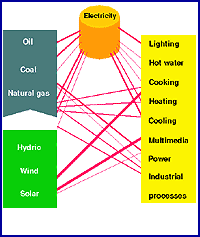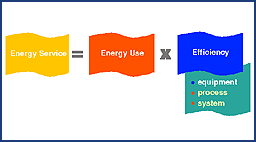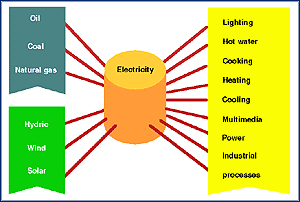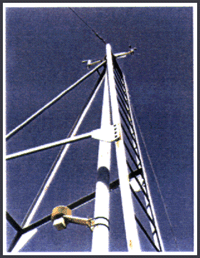The EXPO’98
and the Agenda XXIThe EXPO’98, inspired by an environmental theme, could not fail to
address the questions posed by the associated impact on the environment of its
urbanisation, and to seek to provide a creative and conclusive response. The Parque
EXPO'98 defined a Global Strategy for Energy and the Environment to be implemented right
from the initial stages of the project and extending throughout 1998, based on the
following concepts:
- Energy, in its different forms and by means
of mechanisms for its conversion, transportation and use is the main source of
environmental damage.

- From the point of view of managing the
demand side, energy is not a commodity nor a factor of production, but rather a service.
- The consumers of energy demand the services
which energy can provide: heating, cooling, lighting, transportation, communication, etc.
independently of the form the raw energy takes.
- The energy service is equivalent to the
energy used times its efficiency. The greater its efficiency, the less expensive the
energy becomes.
- Cities may be considered as controlling
dominions or areas for the management of natural resources given that they
"consume" a very significant proportion of these natural resources.
- A demand management policy should ensure an
open range of options concerning raw and final energy. Included in this are the
conventional energies, which should be made use of by using the most efficient systems
available.
- More importantly, there are natural or
renewable sources of energy, the use of which could be understood as the result of the
application of a generalised strategy of demand management.
- The most efficient applications of
environmental energy in the particular case of the EXPO’98 are to be found in the
change to seeking conventional energy by means of relatively simple and efficient passive
and active technology applied to buildings and urban planning.
 |
 |
These concepts were applied in the Global Strategy for Energy and the Environment,
namely in strategies for the
Climate and Micro-Climate, Urban Planning,
the Infrastructure Project and the Buildings Project.
Climate and
Micro-climate
The strategy adopted in the EXPO’98
sought to promote the potential use of the forms of energy available in the environment,
by the collection and treatment of information specific to the place itself, appropriately
configuring it according to the requirements of the planners and project designers.
This information was relevant in the choice
of vegetation and the seating arrangements, so as to create appropriate micro-climates and
to correct the adverse effects of breezes in areas of public use.

The steps taken include:
- Installation of an automatic meteorological station on location,
recording the temperature of the air, the water and the soil, relative humidity, wind
speed and direction and solar radiation.
- Monthly reports issued by the Meteorological
Institute.
- Calculation of solar radiation and natural
light occurring during the average year in the public areas and buildings defined in the
EXPO’98 Master Plan.
- Wind tunnel and computerised studies of the
effects created by the atmospheric circulation in public spaces and around the buildings.
- Integrated study of the comfort parameters
in the outdoor spaces.
Urban
Planning
Urban planning in itself has an
extraordinary potential for the promotion of the use of forms of environmental energy in
dictating the rules of allotting the land, measurement and volume of construction,
groupings, the relationship between public and private domains and the type of landscaping
used. In the EXPO’98 the "Terms of Reference" for its urban planning sought
to introduce certain criteria for energy and the environment as an objective contribution
to the fine adjustment of solutions. Although the environmental objectives of the urban planning in this context were
in line with the more general objectives, significant results were able to be achieved.
Some characteristics of the Urban Planning:
- A dynamic urban space with its own identity.
- Continuity with the existing urban fabric.
- Diverse uses of the land, of urban
morphology and of aedilic typologies.
- Enhancement of the riverfront and the unique
qualities of the light of the Mar da Palha (Sea of Straw).
- Appropriate provision of the right to air
and light.
- Compact building blocks contrasting with the
traditional typologies of Lisbon.
- Preferential North-South alignment of the
elevation of the buildings.
- Maximisation of the view of the river.
- The formation of a sound barrier along the
railway line staggered arrangement of the buildings.
Infrastructure
Project
Urban Network for the Distribution
of Heating Fluids
Indicative estimates that the heating and cooling of buildings would represent the largest
proportion of the overall energy consumption of the Intervention Zone led to the
implementation of an integrated heating fluid
distribution service on an urban scale as a means of optimising energy / the
environment of the supply side.
The production plant of heat and
refrigeration will operate by co-generation by natural gas turbines.
 The heating fluid distribution network will allow
economies of scale by the elimination of each building having its own energy station, will
contribute to a greater diversification of energy and will reduce the consumption of raw
energy and the emission of pollution. On a local scale, the reduction in the consumption
of electricity by relocating the demand associated with heating and climate control, could
be greater than 100 MW. In the buildings, the elimination of autonomous equipment for the
production of heat and refrigeration brings benefits in terms of space, aesthetics and
noise reduction. In an urban context, it enables the prohibition of window
air-conditioning units in the EXPO’98 intervention zone. The heating fluid distribution network will allow
economies of scale by the elimination of each building having its own energy station, will
contribute to a greater diversification of energy and will reduce the consumption of raw
energy and the emission of pollution. On a local scale, the reduction in the consumption
of electricity by relocating the demand associated with heating and climate control, could
be greater than 100 MW. In the buildings, the elimination of autonomous equipment for the
production of heat and refrigeration brings benefits in terms of space, aesthetics and
noise reduction. In an urban context, it enables the prohibition of window
air-conditioning units in the EXPO’98 intervention zone.
Buildings
Project
The buildings project in the EXPO’98
was regulated by the Terms of Reference defined in the Global Strategy for Energy and the
Environment. Their objective was not to establish a group of obligatory prescriptive rules
for all the buildings, but rather to follow a more didactic approach, transferring a large
part of the emulation process implied by each project solution to the project teams.
Being very strict in their demands, the
Terms establish indices of energy efficiency corresponding to 50% to 60% of the values
required by national regulations for passive and active systems, representing a
significant advance, given that the project solutions need to integrate a significant
proportion of environmental energy to reach these indices.
Preference was given to simple project
solutions, such as direct gain, thermal storage in the mass of the structure, passive
cooling by external shading, followed by active solutions resorting to systems based on
commercial energy. This project strategy clearly assumes and integrating and
interdisciplinary attitude which the EXPO’98 sought to encourage with the
consultation of the project teams.
Some emblematic buildings:
Multipurpose Pavilion ( Pavilhão Multiusos )
Exposition Centre of Lisbon ( Centro
de Exposições de Lisboa )
Parque EXPO’98 Building ( Edifício
EXPO'98 )
Green Tower ( Torre Verde )
RESULTS
The goals established for the EXPO’98
were to achieve about a 50% reduction in the regulatory energy requirements in respect of
the building itself and about 60% to 70% of the goals set out in the applicable legal
documents for the greater part of the buildings with systems, that is to say, to create a
new city which, under normal operation and conditions of full comfort and well-being, had
a consumer potential equal to one half of any other city in the same climatic and
urbanistic context.
Without attempting to be exhaustive in
terms of tangible results, the following may be listed:
- Influence on urban planning and the detailed
plans in many aspects of their conception, which it would not be realistic to impute
exclusively to this area, but which was expressed in the actual legal wording of the
detailed plans.
- Creation of a network of heating and
refrigeration with a structuring character of the energy services for heating and cooling.
- Counselling, with very open and fruitful
dialogue with those responsible for the building projects, both in terms of architecture
and energy systems.
- A significant reduction of installed power
systems and the energy estimated for the various buildings in the framework of the general
objective of a 50% reduction.
If these results are converted into
information corresponding to the effects in terms of a reduction in the production of CO2
and the conditions of hygiene and comfort, both indoors and outdoors, then it will be
possible to become aware of the relevance of the approach to energy and the environment
which has been modestly pointed out here.
|

